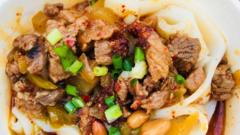In an intriguing twist on dining culture, food enthusiasts in China have found an unexpected hotspot for culinary delight at Erlong Funeral Home in Guizhou province. The canteen within the funeral home has gained notoriety for its spectacular noodle dishes, particularly their renowned bowl of noodles topped with minced pork and peanuts, prompting a surge of interest after a social media post depicted the mouthwatering meal.
As word spread online, crowds began to gather—not all of whom were actually there to mourn. Reports emerged of hungry diners posing as relatives of the deceased, leading to an overwhelming influx of patrons and prolonged waiting times for the coveted dish. An Erlong worker admitted that identifying genuine mourners can be challenging amid bustling queues, as the demand for noodles continues to rise.
To accommodate the increasing number of curious eaters, the funeral home has decided to offer 50 bowls of noodles daily to outsiders, stipulating that this should not interfere with the solemnity of mourning activities. The special noodles, priced at a mere 10 yuan per bowl (approximately $1.38), are traditionally prepared for those involved in funeral arrangements, yet they have inadvertently become a sought-after meal for food lovers.
The noodle craze took off after a social media user shared a glowing recommendation of the funeral home's food, highlighting the paradox that the queue for meals often surpassed that of mourners paying their respects. Compelled by tales of the dish's delectable flavors, visitors have shared their own experiences, leading to a broader conversation about culinary experiences that intertwine life and death in unexpected ways.
With social media platforms like Douyin and Xiaohongshu buzzing with mentions of the famous noodles, it appears that Erlong Funeral Home has unintentionally transformed the conventional notion of a solemn setting into a vibrant dining destination for adventurous foodies. As this unique intersection of culture and cuisine continues to captivate the public, it raises thoughtful questions about the intersection of tradition and modern food experiences in contemporary society.























